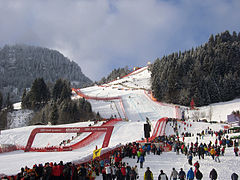Hahnenkamm, Kitzbühel
| Hahnenkamm | |
|---|---|

Hahnenkamm above Kitzbühel, May 2005
|
|
| Highest point | |
| Elevation | 1,712 m (5,617 ft) |
| Coordinates | 47°25′27″N 12°21′55″E / 47.42417°N 12.36528°ECoordinates: 47°25′27″N 12°21′55″E / 47.42417°N 12.36528°E |
| Geography | |
|
Location in Austria
|
|
| Location | Tyrol, Austria |
| Parent range | Kitzbühel Alps |
| Streif - Downhill | |
|---|---|

Finish area (Ziel) in 2011
|
|
| Vertical | 860 m (2,822 ft) |
| Top elevation | 1,665 m (5,463 ft) |
| Base elevation | 805 m (2,641 ft) |
| Longest run | 3.312 km (2.058 mi) |
The Hahnenkamm is a mountain in Europe, directly southwest of Kitzbühel in the Kitzbühel Alps of Austria. The elevation of its summit is 1,712 metres (5,617 ft) above sea level.
The Hahnenkamm (German: rooster's comb) is part of the ski resort of Kitzbühel, and hosts the annual World Cup alpine ski races, the Hahnenkammrennen. The most famous slope on the Hahnenkamm is the classic downhill course, the Streif (streak, or stripe), which is regarded as the most demanding race course on the World Cup circuit. The course features highly technical, "fall-away" turns (reverse bank), many with limited visibility. It also contains several flat gliding sections, immediately preceded by difficult turns, placing a premium on both technical and gliding skills. A run on the mountain's northeast face, the Streif course, is mostly in the shade in January. It is usually overcast and coupled with fog, the result being "flat" lighting which compounds the course's difficulty.
The Hahnenkammrennen are the annual races, held since 1931 and a fixture of the men's World Cup since its inception in the 1967 season. The races were originally held in March, and sometimes in early February (1949 & 1951). Beginning in 1953, the races at Kitzbühel have been held in mid to late January, often the week following the Lauberhorn in Wengen, Switzerland, another classic downhill.
Since 1959, the race has been broadcast on Austrian television.
...
Wikipedia

